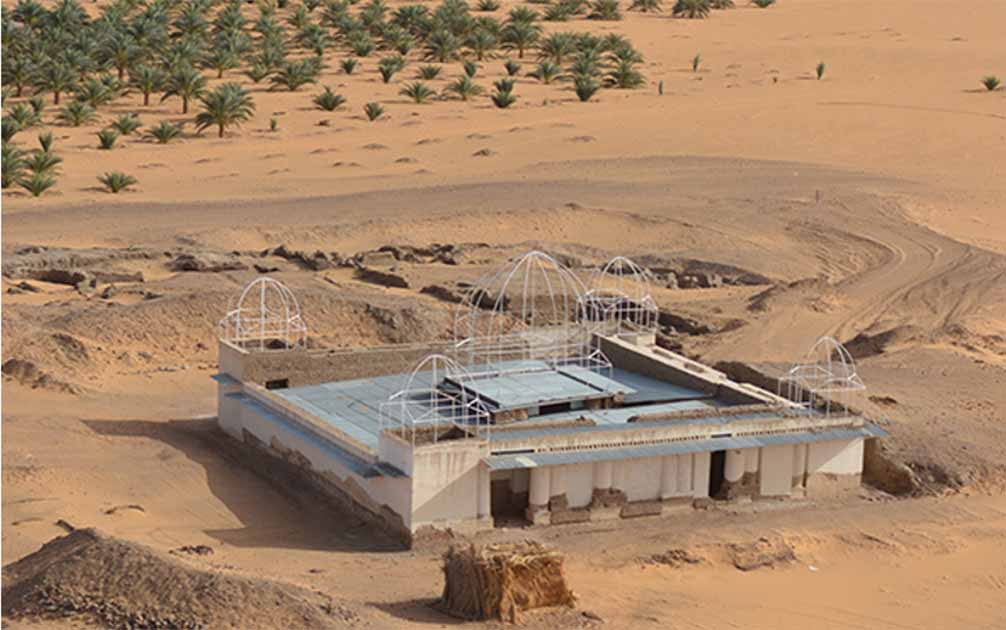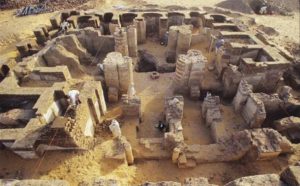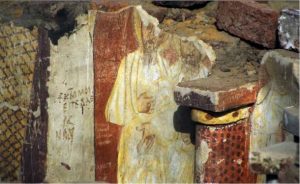Banganarti’s Ancient Christian Faith Center, The Raphaelion

Banganarti, a famous archaeological site on the eastern bank of the Nile, is one of the most popular sites in Sudan. Within this site is the Raphaelion, a church that dates back to the 7th century AD and is one of the best examples of Christian Architecture in the region.
This building has some unique features fascinating to all who are able to visit it. So what is the history behind this fascinating building, and what was it like for those seeking faith healing during its peak?
From Kingdoms to Christianity: The Evolution of Banganarti
Banganarti is found in the Nubia region of Sudan. While today it is an archaeological site, it actually has a rich and fascinating history behind it.

The Raphaelion in Banganarti during documentation and conservation works carried out in the 2004 season. (B. Żurawski/University of Warsaw)
Banganarti and its surrounding area used to be part of the ancient Nubian kingdoms, including the Kingdom of Kush and the Meroitic Kingdom. These kingdoms thrived between 2000 BC to the 4th century AD along the rich Nile River. During their reign, they had many strong cultural and trade connections with Egypt.
Around the 6th century AD, Christianity entered the region. Missionaries from the Byzantine Empire traveled the region and began to introduce the concept of Christianity until it soon became the dominant religion for the masses. From there, Nubian Christian culture took a strong hold.
Between the 7th and 14th centuries AD, there were many churches, monasteries, and other religious buildings built throughout Nubia. These buildings were used regularly for worship and were a massive part of ancient Banganarti culture. It was during this time that one of its most famous buildings, the Raphaelion, was constructed.
From Banganarti’s Peak to its Unraveling
Banganarti reached its peak between the 8th and 14th centuries AD. At this point, the region was known as a major center for religious and cultural activities, which many individuals would come to visit from other areas.
Because of its prime location along the Nile River, Banganarti was a great location for trade and pilgrimage, attracting a number of merchants, pilgrims, and scholars. There was not only a lot of good trading, but also cultural exchange along this route.
Though it thrived for several centuries, things started to take a turn around the 15th century. Several factors began to contribute to Banganarti’s decline, including political instability, changing trade routes, and the rapid spread of Islam. Soon, the kingdoms dwindled and locals abandoned the region in pursuit of other cities.
Industrial-Scale Looting Destroys Ancient Sudanese Site
‘Gold and the Gods’ opens window to rulers of ancient Nubia
The Enchanting Architecture of the Raphaelion
The Raphaelion is known for its one-of-a-kind architectural features that have fascinated many for centuries. This small church is made of mud bricks, which were one of the most common building materials at the time of its construction.
The layout of the church is rectangular, with a central nave flanked by two smaller side aisles. This design is considered a blend of Byzantine and Nubian construction styles, both of which heavily influenced the design of the rest of the building.
Throughout the church are many intricate decorative elements including carved motifs and frescoes. The Archangel Raphael is believed to be the patron saint of this small upper building, considering the name Raphaelion.

Pilgrim inscriptions densely covering walls inside the Raphaelion. (B. Żurawski/University of Warsaw)
Several walls of the Raphaelion were decorated with impressive wall paintings, as well as nearly 1,000 inscriptions left by pilgrims who visited the region during its prime. These images portray well-known scenes from the Bible, as well as other related religious imagery. One of the most famous paintings shows a Nubian king being protected by an Archangel, who is surrounded by the Apostles.
Leading to the chapel is a doorway with several arches and lintels. The roof was made using wooden beams and a layer of thatched plaster, creating one cohesive and intellectually designed unit.
The small church is a perfect example of the unique architectural style of the region during its development. Given the amount of detail put into it, the Raphaelion was clearly a highly important building within Banganarti at the time. A significant amount of artistry and skill went into this building, and it is clear that it was well-loved by both its creators and visitors.
The Spiritual Haven of the Raphaelion
During its peak, archaeologists say that the Raphaelion was a hugely popular place for religious worship. The Christian population would use this place to show their devotion to God through chapels, prayers, and liturgical services.
It was also popular amongst visitors such as pilgrims, who would come to pay their respects to such a sacred building. They may have traveled to seek blessings, offer prayers, or otherwise engage in acts of devotion to God.

Religious drawings of saints or the Apostles of Christian faith. (B. Żurawski/University of Warsaw)
One thing that pilgrims sought out regularly from the Raphaelion was healing from their ailments. Archaeologists found many inscriptions around the church from pilgrims all asking to be healed from various problems. This is likely because the patron of the church, the Archangel Raphael, was known for his power over human health. Those that were extremely sick would come to the Raphaelion to pray to Raphael to be cured, and it soon became known as a faith healing resort in the area.
Beyond a place for religious worship and healing, many believe that the Raphaelion also likely acted as a place for religious education and instruction. They likely taught and trained clergy by teaching Christian doctrines, and they may have gotten the community engaged by offering public teaching to anyone interested and willing to learn.
Simply put, Raphaelion was the heart of Nubian Christian life within Banganarti. They created that building as a space for worship, and they used it to its fullest extent before Christianity began to decline in later years.
From Pagan To Christian To Islam, Religious Wars In Ancient Sudan
Foundation Rituals of Ancient Egypt: Elaborate Rites Conducted to Protect Great Monuments
Still Unraveling Banganarti’s Enthralling Past
The discovery of Banganarti’s ruins in the 20th century was a major success for archaeologists. Several excavations in the region have helped to uncover and preserve several aspects of the region’s cultural heritage. This has given us valuable insights into Banganarti’s history, including the use of religious buildings like the Raphaelion.
Today, Banganarti is still used as an archaeological site, and historians are working to continue uncovering its deepest, most mysterious secrets.